If you live in Arizona—especially in places like Phoenix, Tucson, Chandler, or Gilbert—you might wonder if brown recluse spiders are a problem. These spiders are known for their violin-shaped marking and venomous spider bites.
The good news is that true brown recluse spiders, which are native to the Midwest, are rare in Arizona. However, some look-alike spider species do live in southern Arizona.
Key Takeaways
- Brown recluse spiders are uncommon in Arizona, but Arizona recluse and desert recluse spiders are found more often.
- These spiders live in dark, cluttered spaces like attics and woodpiles, biting only when disturbed.
- Their bites are venomous but usually less harmful than brown recluse bites, though severe symptoms need medical care.
- Simple prevention steps include sealing cracks, using screens, storing firewood away, cleaning webs, and calling pest control.
Are Brown Recluses Found in Arizona?
Brown recluse spiders are rare in Arizona, but their close relatives—the Arizona recluse and desert recluse—are more common. Both have a light brown color and a violin-shaped marking on their cephalothorax.
Brown recluse spider bites are venomous but less harmful than those of a brown recluse. However, if you notice a blister, swelling, necrosis, or tissue damage, seek medical attention.
Other common spiders in Arizona include black widow spiders with their red hourglass markings, fast-moving wolf spiders, harmless tarantulas, and house spiders that help control pests.
While most types of spiders pose little risk, contact a pest control service if you see signs of an infestation.
Preventing Brown Recluse Spider Infestations

If you suspect brown recluse spiders are in your home, taking action quickly can help prevent a spider infestation from getting worse.
Here are some steps you can follow to make your home less inviting to these dangerous arachnids:
Seal Cracks & Crevices
Inspect your home’s foundation and walls for cracks and crevices.
Brown recluse spiders often enter through small gaps around windows, doors, and vents. Seal these openings using caulk or weatherstripping to block entry points and keep them from sneaking inside.
Keep Garages, Closets, & Crawl Spaces Clean
These spiders prefer dark, cluttered areas like garages, closets, and crawl spaces. Keep these spaces organized and clutter-free. Store items in plastic containers with tight lids instead of cardboard boxes, which provide easy hiding spots for these pests.
Store Firewood & Woodpiles Away from Your Home
Brown recluse spiders often hide in woodpiles, so store firewood at least 20 feet from your home and elevate it off the ground. Always inspect firewood before bringing it inside to prevent these arachnids from accidentally entering your home.
Use Screens on Windows & Vents
Install fine-mesh screens on windows and vents to block spiders from entering your home. Regularly check for and repair any holes or tears. Pay close attention to vents in attics, basements, and crawl spaces, as these areas are common entry points.
Clean Spider Webs Regularly
Brown recluse spiders build webs in hidden areas like basements, corners, and storage spaces. Regularly remove spider webs using a vacuum or long-handled brush. Be sure to empty the vacuum immediately after use to prevent them from escaping.
When to Call Pest Control Services
At Green Home Pest Control, we provide spider control services to safely and effectively remove spiders from your home. Whether you’re dealing with common spiders, black widow spiders, or the Arizona recluse, our team is here to help.
If you keep seeing several spiders or signs of a spider infestation, call us now.



